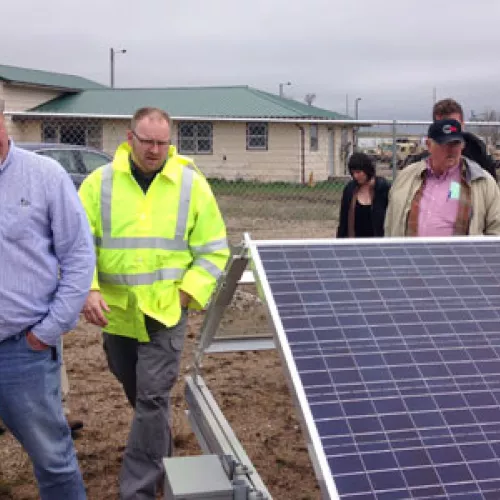On Tuesday, April 18, 2017, over 20 people gathered at City Hall in Hutchinson, Minnesota, to take a driving and walking tour of the many clean energy and sustainability projects that the city has engaged in over the years.
They were greeted by Mayor Gary Forcier, City Administrator Matt Jaunich, Facilities Manager Jeremiah “JJ” Verhey and GreenStep Cities Coordinator and Project, Environmental, and Regulatory Manager John Paulson. The three spoke about some of the energy efficiency upgrades (LED lighting, lighting times/motion sensors, variable frequency drive motors) that have reduced energy costs across the city’s buildings.
“We’re doing it for multiple reasons—economic and environmental—and then we are benchmarking so we can show people where we are saving money,” noted Mayor Forcier.
The city even created its own composting program to process and sell the compost it collects as a way to recoup costs and control taxes. There is also a leaf collection program each fall that on certain days people can sweep their leaves to the curb and the city gladly picks it up to add to their profitable composting business. A win-win arrangement, residents are thrilled that they can skip putting the leaves in bags and hauling them across town.
“It’s about being opportunistic,” said Paulson. “Not just switching out an old lightbulb but looking into switching 20 or more lightbulbs, looking at economies of scale.”
The tour then went to visit the biggest City owned energy user, the Waste Water Treatment Facility. There they were met by Kent Exner, Public Works Director and Randy Czech, Wastewater Operator. Using innovative technology and management practices, the city was able to reduce their baseline power usage at the facility by 20%.
“It’s all about the data,” said Paulson (who is also a WC CERT Steering Committee member). “How is the system performing? How can it be more efficient? The data helps guide decision making processes and saves a lot of legwork.”
The city even re-purposed an old brownfield site next to the waste water treatment plant to host a solar array. Invisible to the naked eye, the panels sit on top of 15 feet of waste from an old landfill, making use of land that wouldn’t be used for any other purposes.
The tour ended at the Depot redevelopment site. The city had recently moved and then renovated their 1889 train depot, creating a permanent farmers market site, a community meeting space, a rain garden, and yet also preserving a significant part of the old depot walls to highlight the historical art and graffiti left on the walls throughout the years. The depot will also serve as a trailhead for a coming bike trail.
“None of this happened by accident,” noted City Administrator Jaunich. “One of our core values is the environment. Everything we do we do for a reason, for a purpose.”
Learn more about Hutchinson’s solar array on a brownfield site.
Check out photos from the event
More links and resources
Listen to an MPR story featuring Hutchinson’s energy work.
Learn more about Hutchinson’s GreenStep Cities participation:
- Some results of Hutchinson’s environmental efforts include the following:
- Public boulevard trees calculated to produce $710,000/yr. in benefits.
- 20% reduction in gas/electric use in City buildings, 2006-2014
- Completion of a 400 kW solar array on a brownfield, lessening the environmental impact of the City. As of its completion, the array was the largest solar project on a brownfield in the state.
- One of the most successful and widespread residential composting programs in the state, diverting 3,800 tons of waste from the landfill in 2015 alone, 1,830 of which is from the source-separated program.
- Over 30 acres of city parkland converted to prairie, saving fuel and expanding wildlife habitat.
- 36 Consecutive years as a Tree City USA.
- Help facilitate a bi-weekly farmer’s market, promoting local foods.
- Recognition as a Bronze Bicycle Friendly Community by the League of American Bicyclists.
- Implementation of a Complete Streets Policy, outlining the City’s dedication to promoting walking, bicycling, and other alternative modes of transportation
- Has begun transitioning streetlights around the City from energy intensive HPS to more efficient LED decorative lights
- Participation in the ENERGY STAR challenge as a Community Partner
Similarly, learn about efforts by the City of St. Cloud to be 80% renewably powered and save energy in their wastewater facility, as well.
About the Local Government Energy Action Series:
This effort tells the stories of Minnesota municipalities, counties, and schools and the tangible results of their energy-saving efforts to inspire others to take their own actions.


